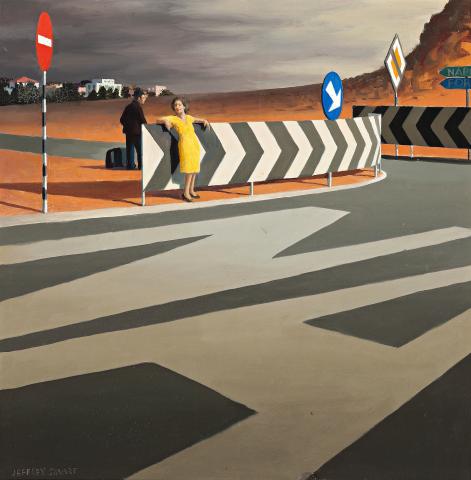STUDY FOR WAITING WOMAN, NAPLES TURNOFF, 1969-70
JEFFREY SMART
oil on canvas on board
37.0 x 36.5 cm
signed lower left: JEFFREY SMART
bears inscription verso: "WAITING WOMAN NAPLES TURNOFF" / 19-11-71 / ... / CAT. NO – 16
Macquarie Galleries, Sydney
Roy and Nancy Melick, Sydney
Estate of Nancy Melick OAM, Sydney
Jeffrey Smart, Macquarie Galleries, Sydney, 17 – 29 November 1971, cat.16
Quartermaine, P., Jeffrey Smart, Gryphon Books, Melbourne, 1983, p.112, no.566
McDonald, J., Jeffrey Smart: Paintings of the ’70’s & ‘80's, Craftsman House, Sydney, 1990, p.157, no.42
Italy was even more scenic from the autostrada …the only signs were those for the traffic and I found them beautiful, they were so well designed.’1
Undoubtedly one of the great paradoxes of Jeffrey Smart’s widely acclaimed legacy is that symbols of modernity, pressure and activity such as the autostrada should be imbued with a timeless aura of stillness, order and harmony more akin to the Italian art of the Quattrocento. For indeed, while drawing inspiration from the urban environment that has flourished in Italy since the Second World War, Smart’s immaculate compositions invariably bear no trace of the chaos or randomness of the world from which they derive. Rather, he skilfully deconstructs the modern city, reducing it to pure geometrical forms in the manner of his artistic mentor Cezanne to encourage his audience to see the ‘everyday’ with fresh eyes, to discern beauty in the most unprepossessing, unromantic of subjects. As articulated eloquently by Smart in his oft-quoted adage, ‘the subject matter is only the hinge that opens the door, the hook upon which one hangs the coat.’2
That Smart’s priority has always been the pursuit of the consummate composition is poignantly illustrated by the evolution of Waiting Woman Naples Turnoff 1969-70 (private collection). Arguably one of the artist’s most celebrated and iconic images, the final composition was preceded by both the oil study offered here and a suite of nine oil sketches which variously position (and even omit altogether) the two figures in different configurations of the roadscape. In viewing the present work alongside the nine vignettes (which appear as if cascading stills from a film shoot and, like the work on offer, are mirror images of the final composition), certainly one gleans the overwhelming impression that the ‘architecture’ of the road does not merely provide a stage for the figures but in its placement, lighting, colour and perspective, occupies the picture space in its own right, with the various components manipulated to optimise visual harmony. As Smart himself has acknowledged, ‘…my only concern is putting the right shapes in the right colours in the right places.’3
In their deliberate orchestration, Smart’s paintings have not surprisingly been compared to Italian films of the 1950s and 60s by Fellini, Antonioni and Pasolini which, similarly exploring the beauty of post-war Italian cities, typically feature carefully composed shots distilled for poetic effect. However, with the viewer here cast as driver, Study for Waiting Woman Naples Turnoff also betrays strong affinities with the 1970s road movies of Wim Wenders where the narrative unfolds through the windscreen of a car, with the audience invited to relate to the nomadic, unfulfilled characters who fleetingly experience happiness before being compelled to move on.4 The experience is thus vicarious and voyeuristic; the viewer is implicated in scenes yet simultaneously isolated from them. In a similar vein, there exists a powerful symbolic conflict between the accessibility and the vulnerability of the figures here – the confident, brightly dressed prostitute leans nonchalantly against the lateral road sign waiting for customers (implicitly the viewer/driver), while the balding suited figure waits for a lift (and therefore, also for us). Curiously, they both seem unaware of each other – and yet there is an unmistakable, awkward sexual tension between them that is only heightened by the brooding sky.
Like the best of Smart’s achievements, Study for Waiting Woman Naples Turnoff remains infinitely suggestive, but confirms nothing. While the dramatic confrontation with two metaphorical ‘lost souls’ may be construed as a bleak commentary upon the alienation of man in a post-industrial age, such pessimistic interpretation however, would seem to negate the artist’s own professed intentions for his art. As Quartermaine ultimately reiterates, ‘…Smart’s paintings are not to be looked through but looked at. If we look through them we find only the preconceptions we brought with us – by looking at them with the attention they demand we can experience their world.'5
1. Smart, J., Not Quite Straight: A Memoir, William Heinemann Australia, Melbourne, 1996, p. 386
2. Smart cited in Jeffrey Smart Retrospective, Art Gallery of New South Wales, Sydney, 1999, p. 14
3. Ibid.
4. McDonald, J., Jeffrey Smart: Paintings of the ‘70s and ‘80s, Craftsman House, Sydney, 1990, p. 28
5. Quartermaine, P., Jeffrey Smart, Gryphon Books, Melbourne, 1983, p. 78
VERONICA ANGELATOS
